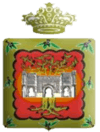Meknes
| Meknes مكناس / ⴰⵎⴽⵏⴰⵙ / Meknès | ||
|---|---|---|
| Prefecture-level city | ||
|
Bab Mansour Gate, the historical sign of Meknes. | ||
| ||
|
Nickname(s): العاصمة الاسماعيلية مكناسة الزيتون The Ismaïlian Capital The médina of 100 minarets. | ||
 Meknes Location in Morocco | ||
| Coordinates: 33°53′42″N 5°33′17″W / 33.89500°N 5.55472°WCoordinates: 33°53′42″N 5°33′17″W / 33.89500°N 5.55472°W | ||
| Country |
| |
| Region | Fès-Meknès | |
| Prefecture | Meknès Prefecture | |
| Government | ||
| • Mayor | Abdellah Bouanou[1] | |
| • Prefect | Abdelghani Sebbar[2] | |
| Elevation[3] | 546 m (1,792 ft) | |
| Population (September 2014) | ||
| • Prefecture-level city | 835,695 [4] | |
| • Rank | 6th in Morocco | |
| • Urban | 656,635 | |
| • Metro | 1,000,000 | |
| Time zone | GMT (UTC±00:00) | |
| • Summer (DST) | WEST (UTC+01:00) (UTC) | |
| Postal code | 50000 | |
| Website |
www | |
Meknes (French: Meknès; Arabic: مكناس Mknas; Berber: ⴰⵎⴽⵏⴰⵙ, Ameknas ; Spanish: Mequinez) is one of the four Imperial cities of Morocco, located in northern central Morocco and the sixth largest city by population in the kingdom. Founded in the 11th century by the Almoravids as a military settlement, Meknes became a capital under the reign of Sultan Moulay Ismaïl (1672–1727), the founder of the Alaouite dynasty. Sultan Moulay Ismaïl turned it into an impressive city in Spanish-Moorish style, surrounded by high walls with great doors, where the harmonious blending of the Islamic and European styles of the 17th century Maghreb are still evident today.[5] The urban population is estimated at more than 650,000[6] with the metropolitan population close to 1,000,000. It is the seat of Meknès Prefecture and an important economic pole in the region of Fès-Meknès.
Etymology
Meknes is named after a Berber tribe which, was known as Miknasa (native Berber name: Imeknasen) in the medieval North African documents.
| Historic City of Meknes | |
|---|---|
| Name as inscribed on the World Heritage List | |
 | |
| Type | Cultural |
| Criteria | iv |
| Reference | 793 |
| UNESCO region | North Africa / Arab States |
| Inscription history | |
| Inscription | 1996 (20th Session) |
History
The Almoravids founded a fortress in Meknes during the 11th century. It resisted the Almohads rise, and was thus destroyed by them, only to be rebuilt in a larger size with mosques and large fortifications. Under the Merinids it received further madrasas, kasbahs and mosques in the early 14th century, and continued to thrive under the Wattasid dynasty. Meknes saw its golden age as the imperial capital of Moulay Ismail following his accession to the Sultanate of Morocco (1672–1727). He installed under the old city a large prison to house Christian sailors captured on the sea, and also constructed numerous edifices, gardens, monumental gates, mosques (whence the city's nickname of "City of a Hundred Minarets") and the large line of wall, having a length of 40 kilometres (25 miles).
According to the ICOMOS Heritage at Risk report of 2000, the historic city of Meknes contains insufficient drainage systems, and as a result suffers from inundation and leakage in certain areas.[7]
Geography
Meknes is located in a strategic position in the heart of Morocco, to its south and south-east are the rich cedar forests and mountains of the Middle Atlas mountains with the cities Ifrane and Azrou; and more to the south are the rich oases of Tafilalt. To the west are the two largest metropolitan areas of Morocco: Casablanca and Rabat. To the north is the mountainous north of Morocco with the cities of Tangier and Tétouan. East of Meknes includes a large number of cities of which Oujda and Fes.
Climate
Meknes has a Mediterranean climate with continental influences. Its climate is similar to some areas of southern Spain. The temperatures shifts from cool and cold in winter to hot days in the summer months of June–September. The nights, however, are always cool (or colder in winter), with daytime temperatures generally rising 10-14C above the low every day. The winter highs typically reach only 15.5 °C (59.9 °F) in December–January, whereas night temperatures average 3 °C (37 °F). (see weather-table below).
It rarely snows in Meknes.
| Climate data for Meknes (1961–1990, extremes 1919–1993) | |||||||||||||
|---|---|---|---|---|---|---|---|---|---|---|---|---|---|
| Month | Jan | Feb | Mar | Apr | May | Jun | Jul | Aug | Sep | Oct | Nov | Dec | Year |
| Record high °C (°F) | 26.9 (80.4) |
28.7 (83.7) |
32.6 (90.7) |
36.4 (97.5) |
40.4 (104.7) |
43.9 (111) |
45.2 (113.4) |
46.2 (115.2) |
43.0 (109.4) |
37.7 (99.9) |
36.4 (97.5) |
27.1 (80.8) |
46.2 (115.2) |
| Average high °C (°F) | 15.3 (59.5) |
16.6 (61.9) |
18.6 (65.5) |
20.0 (68) |
23.8 (74.8) |
27.8 (82) |
32.7 (90.9) |
32.6 (90.7) |
29.6 (85.3) |
24.5 (76.1) |
19.3 (66.7) |
15.6 (60.1) |
23.0 (73.4) |
| Daily mean °C (°F) | 10.2 (50.4) |
11.5 (52.7) |
12.9 (55.2) |
14.4 (57.9) |
17.7 (63.9) |
21.2 (70.2) |
25.2 (77.4) |
25.3 (77.5) |
22.9 (73.2) |
18.7 (65.7) |
14.2 (57.6) |
10.7 (51.3) |
17.1 (62.8) |
| Average low °C (°F) | 5.2 (41.4) |
6.3 (43.3) |
7.2 (45) |
8.8 (47.8) |
11.5 (52.7) |
14.6 (58.3) |
17.7 (63.9) |
17.9 (64.2) |
16.2 (61.2) |
12.8 (55) |
9.1 (48.4) |
5.8 (42.4) |
11.1 (52) |
| Record low °C (°F) | −4.2 (24.4) |
−2.6 (27.3) |
−0.8 (30.6) |
0.5 (32.9) |
0.4 (32.7) |
5.2 (41.4) |
7.2 (45) |
9.0 (48.2) |
5.0 (41) |
2.2 (36) |
0.0 (32) |
−3.0 (26.6) |
−4.2 (24.4) |
| Average precipitation mm (inches) | 89.4 (3.52) |
84.4 (3.323) |
78.4 (3.087) |
74.3 (2.925) |
42.6 (1.677) |
12.5 (0.492) |
2.1 (0.083) |
1.9 (0.075) |
14.1 (0.555) |
47.4 (1.866) |
79.6 (3.134) |
81.2 (3.197) |
607.9 (23.933) |
| Average precipitation days | 10.5 | 10.1 | 9.9 | 10.3 | 7.3 | 3.5 | 0.9 | 1.4 | 3.4 | 7.6 | 9.8 | 9.6 | 84.3 |
| Average relative humidity (%) | 75 | 78 | 76 | 75 | 72 | 68 | 57 | 57 | 62 | 70 | 72 | 77 | 70 |
| Mean monthly sunshine hours | 174.3 | 176.2 | 226.6 | 236.9 | 283.4 | 305.5 | 347.8 | 328.4 | 264.4 | 227.7 | 176.5 | 165.8 | 2,913.5 |
| Source #1: NOAA[8] | |||||||||||||
| Source #2: Deutscher Wetterdienst (extremes and humidity)[9] | |||||||||||||
Quarters
|
|
|
|
Prefecture
Meknes is the seat of the prefecture of Meknès, which consists of 6 municipalities (including the city Meknes) and 15 rural communes.[10]
Main sights
The following map depicts some of the monuments in the old Medina and a general view over the old and new parts of Meknes.
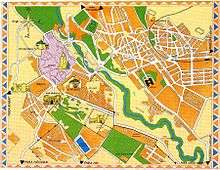
Médina - Historic City

 Bab Mansour Gate, its building finished in 1732
Bab Mansour Gate, its building finished in 1732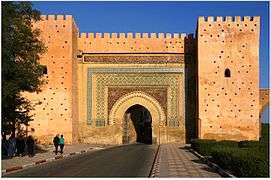 Bab El Khemis Gate, built in 1673, near the quarter of Riad and Mellah.
Bab El Khemis Gate, built in 1673, near the quarter of Riad and Mellah.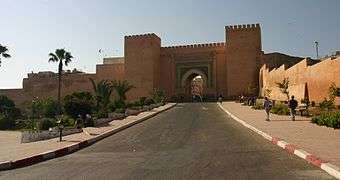 Bab Berdaine Gate built in the 17th century.
Bab Berdaine Gate built in the 17th century.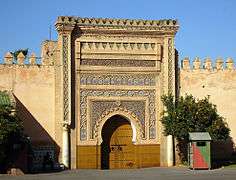 Dar El Makhzen royal palace.
Dar El Makhzen royal palace.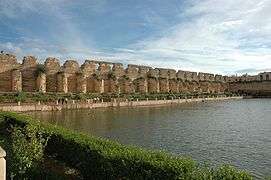 Sahrij Swani.
Sahrij Swani.
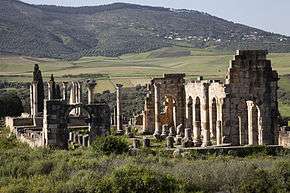
- Volubilis This site is one of the most famous sites in Meknes. It is a site of Roman construction. It is located on a hill where tourists can see the spread out countryside and also see the pieces of the once tall and grandeur Roman villa. Many artifacts from this site are also located in the Rabat's Archaeology Museum but the floors of the villas remain at the original site.
- Medina Medina, or "Old Town", is home to a 12th-century mosque called the Grand Mosque. It sits in the center of the Medina. Also, in the Medina is the The Dar Jamai. It was originally the home of the Jamai family. In 1920, it was made into the Museum of Moroccan Art. The museum still has the same interior designing as the house originally did. Most of the art is from around the Morocco region and there is a room decorated like it would have been in the 19th century. The museum is located in the El Hedem Square.
- Dar El Makhzen palace, located in El Mechouar Stinia. It is sided by a 2 km-long corridor formed by two large walls. It was Moulay Ismaïl's official palace.[11]
- Bab al-Mansour gate, named after the architect, El-Mansour. It was completed 5 years after Moulay Ismail's death, in 1732. The design of the gate plays with Almohad patterns. It has zellij mosaics of excellent quality. The marble columns were taken from the Roman ruins of Volubilis. When the structure was completed, Moulay Ismail inspected the gate, asking El-Mansur if he could do better. El-Mansur felt complied to answer yes, making the sultan so furious he had him executed. Still, according to historical records, the gate was finished after Moulay Ismail's death. The gate itself is now used as an arts and crafts gallery; entry is by a side gate. This is the main gate between the Medina and Imperial City of Meknes. It is designed with Almohad patterns and some of Volubilis's columns were taken apart to build the wall.
- Lahboul gardens. It houses a zoological garden and an open-air theatre.
- Mausoleum of Moulay Ismail, built in 1703 by Ahmed Eddahbi
- Koubat Al Khayatin ("Ambassador's Hall"): a pavilion in which sultan Moulay Ismaïl received foreign ambassadors.
- Bab El Khemis: a large decorated gate from the 17th century.
- Bab Berdaïne: a majestic gate built by Moulay Ismaïl in the 17th century.
- Dar El Beida, a 19th-century palace built by sultan Mohammed ben Abdallah. It is currently home to the Royal Military Academy.
- Royal stables
- Agdal reservoir, built by Moulay Ismail. It measures 319 x 149 meters, with a depth of 2 m.
- Cara subterranean prison.
The ruins of the Roman town of Volubilis (Oualili) are about half an hour to the north.
Mosques
Some of the historic mosques in Meknes include:
Néjjarine Mosque
Néjjarine Mosque built in the 11th century by Almoravids, located in the old city(médina). Actually the mosque is closed due to some maintenance work.
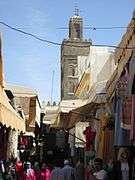 Minaret of the historic Néjjarine Mosque.
Minaret of the historic Néjjarine Mosque.
The Grand Mosque
The Grand Mosque built on a surface of more than 2,700 square meters, founded in the 11th century by the Almoravids. It has 11 gates and 143 arcades, a very old and historic library was established by the Marinids that actually still opens for readers. The Grand Mosque is situated in front of the Madrasa Bou Inania.


Madrasas
Madrasa Bou Inania
Established by the Marinid sultan Abu al-Hasan and construction was completed by his son Abu Inan in 1345.[12]
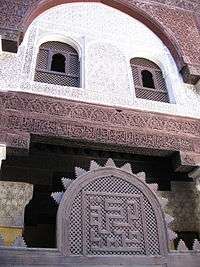 Medresa Bou Inania in Meknes.
Medresa Bou Inania in Meknes. Inside the Medresa Bou Inania in Meknes.
Inside the Medresa Bou Inania in Meknes.
Economy
Meknes is an economical center in Morocco with various products from the three economical sectors (agriculture, industry and services), which makes the city economically competitive and attractive for investments.
Competitiveness
A December 2015 World Bank report classified Meknes as one of the three most competitive cities in Africa.[13] Two of those three competitive African cities are from Morocco: Meknes and Tangier.
Agriculture
Meknes is considered to be the capital of agriculture in Morocco. And the Saïss plain is one of the fertile and rich plains in Morocco and Meknes is the center of this plain. [14]

Meknes city holds each year the International Agriculture Show in Morocco(French: Template:Salon International de l'Agriculture au Maroc) since April 2006. This agriculture show has an area of more than 250000 square meters, with more than 60 countries participating, and more than 1200 exhibitors.[15] The lands around Meknes area are known to be fertile and productive. The high elevation, fertility and the fresh water of those lands favor the cultivation of fruits and vegetables, most notably: peach, nectarine, prune, apples; potato, onion and garlic. Also, livestock raising, particularly sheep and cattle is widespread. Meknes has large industrial units for milk production and diary that fulfill the most of the needs of the region. Another agricultural product well known for its quality and taste in Morocco is the olive and olive oil from Meknes, and historically talking, Roman Volubilis was a major producer of olive oil.
Industry
Industry in Meknes is of light type, most of it is related to food processing especially in the Commune of Mejjat, and chemical and para-chemical industry in other industrial zones like the Agropolis industrial and agribusiness zone. Add to those the textile and metallic manufacturing which are old industries in the city. The year 2016 marks a new era of new industry in the city of Meknes, it includes electrical wire, embedded systems, and automotive parts production companies.
Major Companies
| Name | Year |
|---|---|
| Yazaki | March 2016 |
| Delphi Automotive | 2016 |
| Yura Corporation | 2016 |
Meknes Agropolis
Agropolis is Morocco's first competitiveness cluster dedicated to agribusiness. Its unique geographical location in central Morocco, together with its agricultural potential, makes it an attractive, rapidly developing platform. Agropolis welcomes investors in a first-class environment offering infrastructure that meets international norms as well as a wide range of real estate services, notably equipped plots of land and delegated management possibilities at competitive rates. Meknes Agropolis is the ideal ecosystem to implement a project focused on agribusiness, logistical activities and marketing, packaging units, tertiary activities, training and R&D.[16]
The first phase of the project has a land surface of 130 ha. The Agropolis Zone is 12 km from Meknes and 2.5 hours drive from Casablanca. Casablanca Port is 246 km far from Agropolis and Tanger-Med Port is 382 km away.
Services
Most of the services products in Meknes are related to Tourism due to the history of the old city district -Meknes Médina-. Of Morocco's four Imperial Cities, Meknes is possibly the least well-known – not as large as Rabat, as fashionable as Marrakech, or as famous as Fez – and you might say that this is to its advantage as you’ll find this historic place quieter and more laid back than its sister cities. It's an enchanting place to visit, with winding narrow streets, a classic medina and grand buildings that hail back to its time as the capital of Morocco. Nearby are the Roman ruins of Volubis and the tomb of Moulay Idriss – two of the most important historical sites in the kingdom. But Meknes is also a modern, lively city with a vibrant nightlife, plenty of bars and a welcoming attitude towards visitors.[17]
Transport
Road
The geographical location of the city of Meknes makes it one of the important transport hubs in Morocco. The city is accessed via the A2 expressway with two exits, one to the east of the city and another to the west.
Rail
Two train stations are located in the new city district(French: Ville Nouvelle) of Meknes, with trains each hour to the east, west, and north of Morocco. Operated by ONCF, the following table lists destinations reachable via Meknes railway stations(Round-trips):
| Direction | Route | Frequency | ||
|---|---|---|---|---|
| West | Fez - Meknes - Kenitra - Rabat - Casa Voyageurs | Every 2 hours | ||
| West and South West | Fez - Meknes - Sidi Kacem - Sidi Slimane - Kenitra - Salé - Rabat - Mohammedia - Casa Ain-Sebaa - Casa Voyageurs - Casa Oasis - Berrechid - Settat - Ben Guerir - Marrakesh | Every 2 hours | ||
| North | Fez - Meknes - Sidi Kacem - Ksar el-Kebir - Tangier - Ksar es-Seghir | 6 trains a day | ||
| East | Casa Voyageurs - Casa Ain-Sebaa - Mohammedia - Rabat - Salé - Kenitra - Sidi Slimane - Sidi Kacem - Meknes - Fez - Taza - Guercif - Taourirt - Oujda | Two trains a day | ||
| West | Meknes - Sidi Kacem - Sidi Slimane - Kenitra - Salé - Rabat - Mohammedia - Casa Ain-Sebaa - Casa Port | 3 trains every Sunday PM | ||
As mentioned above, Meknes city has two train stations, and their names are: Meknes Railway Station(French: Gare de Meknès) and Meknes Amir Abdul Qadir Railway Station(French: Gare de Meknès Amir Abdelkader). All the mentioned trains cited in the previous table stop by the former station; and except the first row of the table, all the remaining trains stop by the latter station.
Air
Meknes and its area are served by Saïss Airport (IATA: FEZ, ICAO: GMFF).
Public Transport
Public transport in Meknes is managed by the urban commune and it consists of:
- A large network of buses that cover all the area of the prefecture, and even outside of the prefecture like the line 16 to El Hajeb.
- Taxis in the city exist in two types: small taxis with 3 places Max that work with fares system; and bigger taxis with 6 places Max that have a predetermined trajectory and fixed prices.
International relations
Twin towns – Sister cities
Meknes is twinned with:
References
- ↑ "Mayor roles and responsibilities", Meknes Web Site, web: Meknes Web Site
- ↑ "Prefect Biography", Meknes Web Site, web: Meknes Web Site
- ↑ "Meknes Elevation and Altitude", Elevationmap.net, web: Map Website
- ↑ "Official Report of General Census of Population and Housing, page 17", High Commission for Planning, web: HCP Web Site
- ↑ http://whc.unesco.org/en/list/793
- ↑ Template:Largest cities of Morocco
- ↑ ICOMOS Heritage at Risk 2000
- ↑ "Meknes Climate Normals 1961–1990". National Oceanic and Atmospheric Administration. Retrieved March 16, 2015.
- ↑ "Klimatafel von Meknès / Marokko" (PDF). Baseline climate means (1961-1990) from stations all over the world (in German). Deutscher Wetterdienst. Retrieved January 26, 2016.
- ↑ Royaume du Maroc (20 November 2008). "Bulletin Officiel № 5684" (PDF) (in French). p. 1600. Retrieved 15 July 2012.
- ↑ "Description of Dar El Makhzen"
- ↑ "Bou Inania madrasa(in Arabic)", Meknes Web Site, web
- ↑ "New Report Highlights the World's Most Competitive Cities", The World Bank, web: World Bank Website
- ↑ A. Essahlaoui, El A. Ouali. "Détermination de la structure géologique de la partie Sud de la plaine du Saïss (bassin de Meknès-Fès, Maroc) par la méthode géoélectrique", Springer Science+Business Media, May 2003. Retrieved on 8 May 2016.
- ↑ "International Agriculture Show in Morocco", SIAM, web: SIAM Web Site
- ↑ "English Presentation of Meknes Agropolis", MEDZ, CDG Group, web
- ↑ "Official Meknes City Tourism portal"
- ↑ "Ville jumelle: Meknes". City of Nîmes. Retrieved 2016-05-25.
External links
| Wikimedia Commons has media related to Meknes. |
- http://www.planetware.com/tourist-attractions-/meknes-mar-mek-mek.htm
- http://looklex.com/morocco/meknes02.htm
- MeknesCity Newspaper
 Meknes travel guide from Wikivoyage
Meknes travel guide from Wikivoyage

